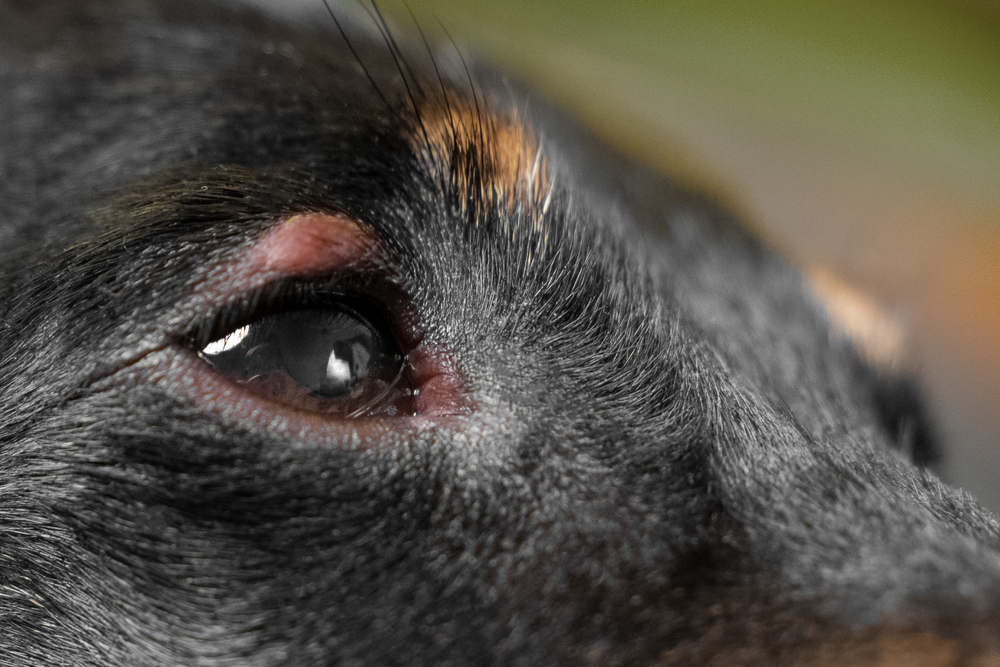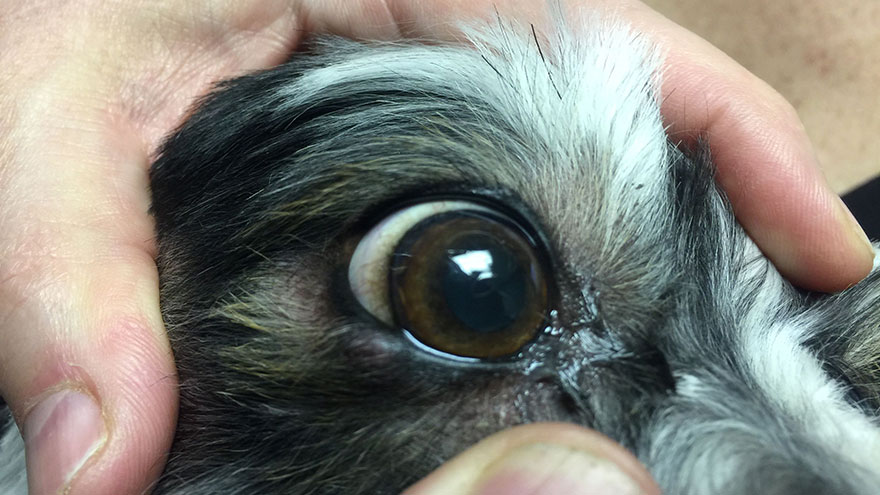
Eyelid Meibomian adenoma amenable to V-plasty correction. Meibomian cysts are lumps in the eyelids caused by blocked oil glands in the lids.

In young dogs they can regress without treatment.
Meibomian cyst on puppy. If you notice a growth on your dogs eyelid it could be whats known as a meibomian gland cyst or chalazion. Both dog and cat eyes may be affected by these but they are more common in dogs. Health Navigator says these are usually caused by blocked oil glands and they are not due to.
Meibomian gland cysts in dogs are tiny little nodules that can form in whats known as the third eye. The third eye aka nictitating membrane is the tissue you see in the corner of the eye. If you watch your dog blink youll see movement of that membrane.
Will My Dog Go Blind. Meibomian cysts or tumors occur on or under the eyelid margin. Meibomian gland tumors are tiny slow-growing tumors that form in the meibomian glands of the eyelids.
A chalazion in dogs is a lump or nodule swelling on the inside edge of the lower or upper eyelid. The plural form for a chalazion is chalazia. A chalazion is also referred to as a meibomian cyst.
Meibomian Cysts also known as eyelid cysts are growths on your dog or cats eyelids. It is more common in dogs than cats. They are usually caused by blocked oil glands.
Cancer of the eye. Lymphoma Melanoma and Neuroblastoma. Cancer of the eye in dogs and cats occur as tumors on the eye.
Meibomian gland tumors in dogs are usually benign non-cancerous so they dont typically spread or move to other areas of the body. Canine meibomian gland tumors can become irritated painful and even infected or they can cause corneal ulcers or conjunctivitis. In dogs Meibomian gland tumors usually grow slowly.
These are tumours of the meibomian glands of the eyelids. These are common in older dogs and start as small bumps at the margin of the upper and lower eyelids. Many of these stay small 2 - 3mm and do not continue to grow further so there is never any rush to have them removed.
Some common types of eyelid tumors in dogs include. Meibomian gland tumors Meibomian gland adenomas ie benign tumors and adenocarcinomas ie malignant tumors comprise approximately 60 percent of the eyelid tumors seen in older dogs. These pink to pigmented lobulated masses arise from the meibomian glands that line the eyelid margins.
Meibomian cyst dog Best Free Online Dog Training Video Courses. When your puppy comes every time you call you are now ready to add some distractions. The first distraction is simply taking your puppy outside.
Because dogs have no logical sense they dont automatically know the definition of come in the house also holds true outside. Meibomian cyst illustration relating to dogs including description information related content and more. All information is peer reviewed.
In Shih Tzus distichia occur in combination with an excessive accumulation of secretion within the meibomian glands. Ectopic cilia also arise from the Meibomian glands but emerge through the palpebral conjunctiva causing corneal irritation oftentimes even ulceration. They can occur in any breed.
However the Flat Coated Retrievers and some brachycephalic dogs Shih Tzu Pug. Characteristics of Meibomian Cyst. A meibomian cyst is a small fluid-filled cyst of the eyelid.
Its usual size is about 2 to 8 mm. As reported meibomian cyst is commonly found in the upper eyelid but still can affect both eyes. Somehow this condition is compared with stye.
But the two are much different from each other. These tumors are tiny slow-growing tumors that form in the meibomian glands of the eyelids. Meibomian glands are sebaceous glands that provide an oily secretion to stabilize the tear film over the cornea Common in older dogs meibomian gland tumors are usually benign but a small percentage of them are carcinomas that can metastasize into lymph.
Eyelid Meibomian adenoma amenable to V-plasty correction. The most common type of elective surgery we perform at Angell Ophthalmology is removal of small eyelid tumors via V-plasty. Eyelid tumors can occur in any breed at any age but older dogs tend to present to our service for evaluation.
Adjacent Meibomian glands may become transiently and mildly inflamed. Infection is not present within the gland once a chalazion has occurred although prior infection of the gland may be a predisposing cause. Most chalazia become quiescent with time developing into focal white or yellow rounded swellings at the base of the Meibomian gland.
Chalazia are commonly seen in older animals and may be associated with meibomian gland adenomas because they usually obstruct the duct leading to glandular rupture. Diagnosis is based on appearance of a focal nonpainful swelling with nodule formation at the level of the meibomian gland through the palpebral conjunctiva. These masses are often viral in origin and they vary in color from white to pink to pigmented and tend to appear pedunculated and cobblestone-like in appearance.
They occur more commonly in young dogs but can occur in dogs of any age. In young dogs they can regress without treatment. Diagnosis Treatment and Prognosis.
Several breeds are known to be predisposed to this type of cancer. This tumor may affect any area of the skin the nosenasal planum or the toes. Fine needle aspiration or biopsy may be performed for diagnosis.
About 30 of dogs with the digital form of the disease will have evidence of spread. Meibomian carcinoma is uncommon in dogs. But they can be infiltrative and metastases via lymphatics to regional lymph nodes have been reported.
The peak incidence is between 6 and 11 and the genetically predisposed breeds include Gordon Setter Samoyed Standard Poodle Shih Tzu Siberian Husky West Highland White Terrier and Labrador Retriever. Meibomian Gland Adenomas MGA are benign age related eyelid tumors which result from the accumulation of glandular material. If they become large enough MGAs can cause irritation to the cornea and conjunctiva and may reduce the normal ability to blink.
In most well behaved dogs we can safely and effectively remove the masses using topical. Using a wedge resection we removed a large Meibomian cyst from a dogs upper lid. Cherry eye is most often seen in young dogs under the age of two.
A sty is often the name given to a bump on a dogs eyelids that appears similar to an isolated pimple. They may also lead to rupture and causes. There are different types of keratitis in dogs such as.
Also known as a chalazion. Meibomian cysts are lumps in the eyelids caused by blocked oil glands in the lids. These lumps often occur in groups.
They are not due to infection and usually resolve over time though this may take some months. Heat and massage can be helpful in clearing them.